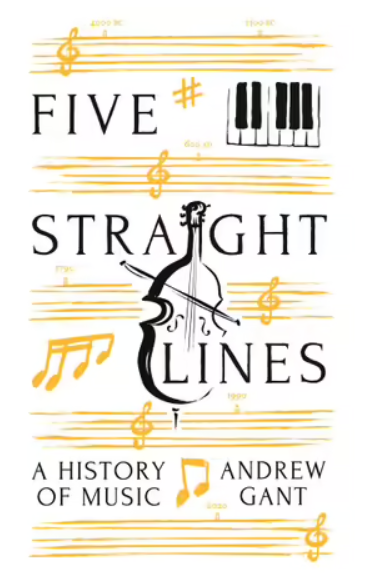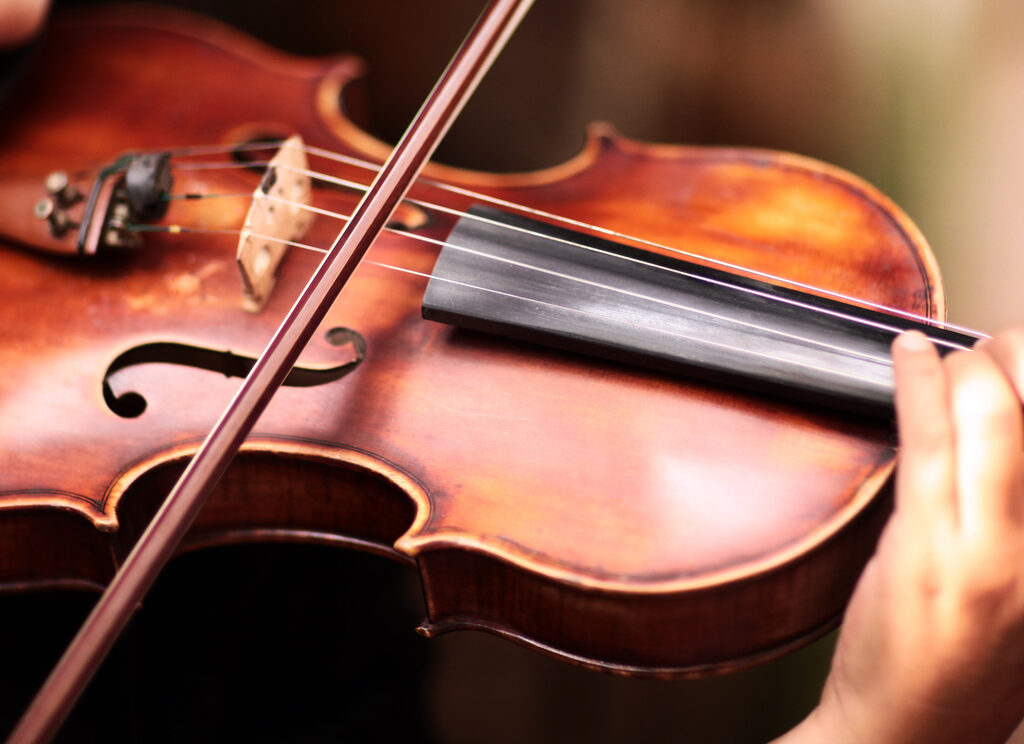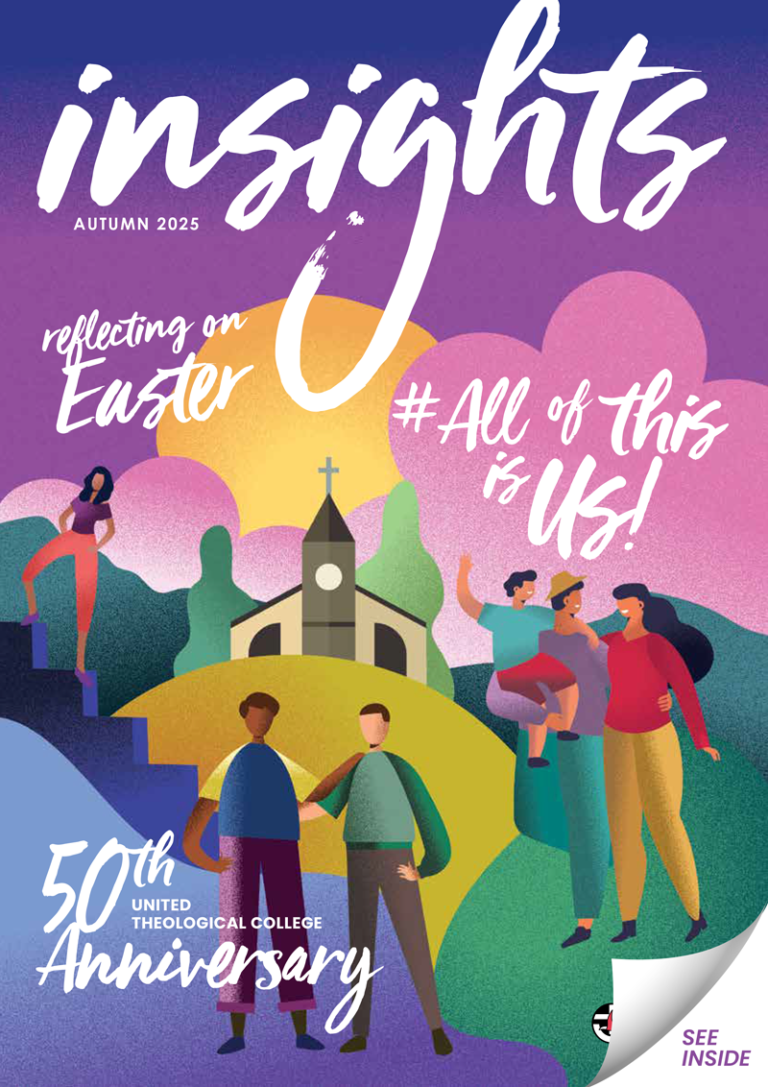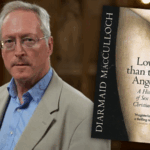Review: Five Straight Lines: A History of Music, Andrew Gant, Profile Books
The evidence of bone flutes tens of thousands of years old indicates that music appeared with the development of complex language, not after. It seems that, for humans, the urge to make music is as fundamental as the urge to draw.
Andrew Gant, who has previously written a history of English church music, writes of this continuous prominence in human history while also asking about fashions and what might be good and bad music. Though a mammoth history of music, it’s not really a global history. It’s essentially a history of Western classical music with a few additions. The bulk of Gant’s book concerns the period of Bach to Brahms. In comparison, the century-long jazz project is dealt with quickly, and rock’n’roll is given a cursory glance. Music is subjective, and Gant does make his preferences known.

The ancient Greeks were, unsurprisingly, big on a mathematical theory of music, especially Pythagoras. Apparently, Confucius had similar ideas relating to the underlying order of the universe. Plato, typically, didn’t like the modern music of his day – it was too loud. It’s a debate that echoes through the ages – the conflict between tradition and innovation. Gant suggests that behind St Paul’s letters may have been annoyance with overly exuberant music in congregations. In 1325 Pope John XXII complained that in the church music of his time there was too much mucking around, and too much pace, taking away from the point of the music, which was to encourage devotion and contemplation.
In the Middle Ages, the music matched the solidity of scared architecture. There was a large repertoire of sacred music. Organum music used tight, matching harmony lines. As music became more polyphonic, a way of noting precise rhythm and time values of notes was needed, and the five straight lines of Gant’s title came into use. Previously, symbols were just inserted over words on a page. Notation was refined over centuries – by the fifteenth, notation had been simplified to pretty much what we use today. By that time, says Gant, musical pieces were more likely to be composed as a whole, like a Palladian building, rather than simply meandering pleasantly. Simpler notation helped.
Church music reigned, yet there was also bawdy secular music, contradicting Philip Larkin’s tongue-in-cheek suggestion that the connection between music and sex was only made in the second half of the twentieth century with the invention of rock’n’roll. Gant suggests that the minstrel music of the time was similar to today’s folk music, and certainly folk music has long arms, reaching back deep into the tradition.
The Middle Ages contained exquisite but ‘technical’ music. The Reformation simplified things somewhat. Erasmus had complained that the music had grown too complicated to be able to discern the words – even the choir didn’t understand what they were singing. Martin Luther thought complex music was ‘heavenly’, yet he borrowed tunes from the pub to set his hymns to. Of course the rise of printing, which coincided with and aided the Reformation, helped to spread popular tunes.
The Renaissance brought about more changes. Monasteries declined and Renaissance music no longer stuck to the mathematics of ancient Greece. Composers were professionals rather than monks. There were new instruments, large choirs with many parts. But the laity was singing too. While there were grand religious works, families (such as the Bachs) filled their homes with music. Pub singalongs were popular; Purcell wrote pub songs (‘some very rude’).
The Baroque, whose key composers were Handel and (the elder) Bach, saw the almost-infinite exploration of counterpoint (the weaving of contrasting and complementary melodies). Melodies were inverted and reversed and chopped and spliced like cubist paintings. Gant suggests that in writing ‘The Art of Fugue’ Bach ‘disappear[ed] inside his own brain’. Bach’s music was old-fashioned even in his day, perhaps contributing to the quick decline of his reputation, which only revived with much later appreciation of his ‘cosmic’ and endless imagination. Still, many saw Baroque music as a dense forest that needed thinning.
Especially for the Baroque, it’s helpful to know about diminished fifths and the like. The experience of reading the book is enhanced by having a musical dictionary (or google) handy, as well as access to Spotify, though Gant helpfully includes explanations of terms such as cantata, academy and submediant, and explains how throughout the history of music, the meaning of such terms is often changing.
The era of classicism saw a change from counterpoint to music heading in the same direction, as Gant puts it, such as that for string quartets. Although sonatas retained some elements of the contrapuntal (using counterpoint) music of Bach et al by playing around with musical themes, simple melody became king. The key to understanding Mozart, says Gant, is opera, and the genius of his operas is simplicity of melody and complexity of character.
The musical history of the seventeenth and eighteenth centuries is, at least for Gant, centred on the evolution and reach of opera. Opera was widely popular, both technical and appealing to the masses, with majestic music, emotional plots, superstars. While court and church composers could be underpaid, opera stars could become very wealthy. The various moods of opera would transform into the movements in nineteenth century symphonies.
For French opera, the 1900s were the ‘long century’. For those of us less enthusiastic about opera, we might feel the same about the chapters dedicated to it. Otherwise, the turn of the nineteenth century ushered in the symphonic era, with the city orchestra replacing court musicians, and the era of the freelance, often ‘genius’, composer.
This was the age of Romanticism. The philosopher Johann Herder, often ahead of the curve, had said in the eighteenth century that music (and art) was about being moved emotionally. The lifestyles of later nineteenth century composers, such as Schumann and Liszt, helped reinforce the stereotype, continuing to today, of the Romantic genius. Though they revered Bach, their music was more emotional than liturgical church music. Listen to, for example, the ‘Ride of the Valkyries’ from Wagner (whom Alex Ross calls the most influential composer ever), and think of John Williams’ scoring of Star Wars and Superman, or the use of Schubert and Strauss in 2001: A Space Odyssey. Romantic symphonic music is often what is popularly thought of as classical music.
Beethoven was the giant of the nineteenth century (though there were plenty of contenders). One far-sighted critic thought Beethoven was far ahead of his times, not writing to suit the skills of musicians, but writing in an abstract universe of his own. It may have been Romantic, but it was very masculine, with fanfares blasting like cannons (literally, in Tchaikovsky’s case). But by the end of the nineteenth century, women, as in other areas of society, were getting a foot in the door. In a back-handed compliment, Fanny Mendelssohn was praised as ‘play[ing] like a man’. The concertos of Clara Schumann, wife of Robert, were widely performed.
The late 19th century was very different to what had come before. Music was high art, rather than something churned out to pay the bills. As with the visual arts, innovation ramped up. Dvorak and Grieg used folk melodies. Chopin was on the cusp of jazz. To Gant, he sounds occasionally like Gershwin, and his pieces would vary when he played them at different venues; as in jazz, there were no definitive versions.
In the 20th century we see a split between the saturation of the simple music of the volk and the stratospheric, rarefied avant-garde. Stravinsky provoked nearly everyone, while the blues and jazz were the beginnings of America’s cultural dominance of the twentieth century. Between these poles there has been a constant cycling of the classical standards, ending in a splintering, in a postmodern, anything-goes free-for-all.
But the biggest post-war innovation has been, arguably, not in the writing of the music itself but in the development of musical instruments, especially with electrification, which obviously opened up further the possibilities of writing. While John Cage had pushed the sonic possibilities of the piano to its sometimes-absurd limits, the synthesizer allowed for previously undreamt-of manipulation of sound, running with the preference of some innovative classical composers for music that went beyond the restrictions of melody and rhythm. Ambient electronic music seems to have reflected back on classical music, influencing the likes of the orchestral music of John Luther Adams. Gant says of ambient music that if you strip out melody and rhythm you have to replace them with something else that is interesting, perhaps missing the point of this type of music.
Electronics have not only affected the avant-garde, of course. Jean-Michael Jarre took synthesisers into the popular mainstream in the 70s, with annoyingly catchy instrumental hits, and the mainstream popular music of today could not exist without them.
Nick Mattiske blogs on books at coburgreviewofbooks.wordpress.com and is the illustrator of Thoughts That Feel So Big.











